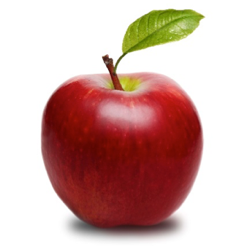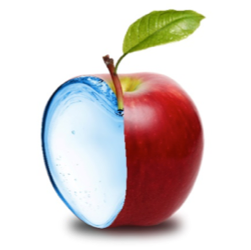


All in all, irrelevant of the apple varieties used, two common denominators tend to come back again and again in the production of authentic ciders:
It therefore makes sense that these two common recurring denominators become the backbone of any cider standard. By using these two variables to define the cider category and by reviewing the most widely used current cider production methods, we identified three main production methods to produce an alcoholic cider in the 5% alc./vol. range. These 3 production methods and main elements relevant to each method are highlighted in the table below:
Single strength cider made with 100% freshly pressed apple juice with no water, sugar, or concentrate added at the fermentation stage.
Also known as high alcohol cider-making – Sugar/fructose is added to the apple juice base and fermented to 10 to 12% alc./vol. Before packaging, 50 to 65% water is added to dilute the alcohol content to 5%.
No apple juice required. The apple concentrate is mixed with water and sugar/fructose and fermented to desired % alc./vol. Anything goes in terms of ingredients and method of production. Final dilution of 65 up to 85% with water.



0 to 20%
50 to 65%
65 to 85%
Identifiable region
Wherever
Wherever
The above three cider production methods for ciders, cocktails and fermented beverages respectively probably account for more than 80% of the ciders and so called ciders currently sold in markets worldwide.
The production methods are straightforward to understand and would be an ideal way to segment and label ciders and other fermented apple-based products currently sold on the market.
They would eliminate the confusion in the cider category where ciders made from 100% apple juice using the single strength cider-making method are sold side-by-side with so called ciders better known as cocktails and fermented beverages. A win-win criteria for producers, retailers and consumers alike.
与葡萄酒、烈酒或啤酒类产品相反,关于苹果酒中实际上应包含哪些成分,目前尚无明确的
理解或定义。目前在市场上出售的许多苹果酒品牌被归类为苹果酒,但是由于它们几乎不含
任何苹果汁,实际上不应作为苹果酒出售。这种现象的结果是,消费者对究竟什么是苹果酒
以及他们对苹果酒类产品的期望是什么存在很大的困惑。对于使用真正的苹果汁生产正品苹
果酒的生产商而言,他们不得不与不含苹果汁的假苹果酒厂商竞争,这让他们感到很沮丧。
除少数例外情况外,并没有可信的机构或区域管理机构对苹果酒标准进行监管。

Contrary to the wine, spirits or beer category, there is currently no established clear understanding or definition of what a cider should actually contain. There are also several cider brands currently sold on the market that are categorized as ciders but since they barely content any apple juice, should really not be sold as ciders. The result has been a fair bit of confusion amongst consumers of what exactly is a cider as well as what to expect from the cider category.
There is also considerable frustration on the part of cider producers that make genuine ciders from real apple juice of having to compete head-to-head with pseudo ciders made with no apple juice. With a few exceptions, there is also no credible institution or regional governing body overseeing cider standards.

尽管这有些老生常谈,但是“并非所有苹果酒都是一样的”这一表述用在今天,比用在任何场合都更贴切。我们希望信任标记的创建是向前迈出的一小步,可以帮助我们改善全球范围
内的苹果酒标准和法规,并可以在改善过程中以可持续的、有意义的方式增加苹果酒类别。

制作苹果酒并不新鲜,关于苹果酒的最早记录可追溯到罗马时代。当时,许多地方已经开始
生产苹果酒,包括法国布列塔尼和诺曼底,凯尔特英国人和西班牙北部部分地区。几个世纪
以来,苹果酒已经成为一种众所周知的商品,甚至有一次,在英国部分地区,它被用来支付
租金。关于苹果酒的生产历史,互联网上有许多信息,包括首家发布信息的华盛顿州立大学
网站
市场上可买到的苹果酒通常分为两大类:现代苹果酒和传统苹果酒。第一类苹果酒主要是使用烹调用苹果,如Cortland、Gala、 Granny Smith 和 McIntosh生产的。第二类苹果酒主要是使用苦甜参半和苦涩的苹果,如Russet、 Crabapple和Kingston Black生产的,这类苹果通常被称为传统苹果。
此外,每类产品均使用不同的生产方法制作苹果酒。例如,许多英国苹果酒使用开放式发酵
桶和苦涩的苹果,通常所含的酒精含量更高。 法国人发明了一种甜的,低酒精含量的苹果
酒,利用更甜的苹果和大桶工艺。
多年以来,苹果酒种类是根据苹果和生产方法的不同组合形成的,而生产方法受许多变量的
影响,如酵母的选择、使用的容器、当地的口味偏好以及环境设置。使用不同苹果,在不同
条件下生产的苹果酒,在酒精含量、口味、甜度、风味和颜色上有很大的差异。现代苹果酒
在外观上与高泡葡萄酒非常接近,而传统苹果酒的颜色更深、更浑浊、苹果味更浓。

总而言之,与所使用苹果的品种无关,在生产正宗的苹果酒时,以下两个共同点往往会反复
出现:
因此,这两个常见的重复分母成为任何苹果酒标准的重要因素都是合情合理的。通过使用这
两个变量来定义苹果酒类别,并通过审查当前使用最广泛的苹果酒生产方法,我们确定了三
种主要生产方法,生产浓度范围为5% alc./vol.的含酒精苹果酒。
下表重点强调了这3种生产方法以及与每种方法相关的主要元素:
单浓度苹果酒,由100%新鲜压榨的苹果汁制成,在发酵阶段不添加水、糖或浓缩剂。
也被称为高酒精度苹果酒——在苹果汁中加入糖/果糖,并发酵至10-12% alc./vol。包装前,添加50%-65%的水,将酒精含量稀释至5%。
不需要苹果汁。将苹果浓缩剂与水和糖/果糖混合,并发酵至所需的浓度%alc./vol。生产出什么样的产品取决于成分和生产方法。最终产品用水稀释到65-85%。



0 – 20%
50 – 65%
65 – 85%
可识别区域
任何地方
任何地方
关于上述三种用于生产苹果酒、鸡尾酒和发酵饮料的生产方法,目前在全球市场上销售的苹 果酒和所谓苹果酒,80%以上是用上述三种方法生产的。
生产方法简单易懂,是对目前市场上出售的苹果酒和其他发酵性苹果饮料进行细分和标识的 理想方式。
采用单强度苹果酒生产方法,用100%苹果汁制作的苹果酒,与更适合被称为鸡尾酒和发酵饮 料的所谓苹果酒一同出售时,它们可以消除区分苹果酒类产品时的困惑。这是实现生产者、销售者和消费者双赢的标准
大约自2010年以来,苹果酒的消费开始出现复苏,使其成为全球增长最快的饮料类产品之一。
英国,被称为苹果酒的发源地,目前仍处于领先地位。尽管过去十年,英国在全球苹果酒市场中所占的百分比已从50%左右下降到35%,但是迄今为止,它仍然是世界上人均消费量最大的苹果酒市场。
苹果酒市场份额大幅下降的主要原因是美国和加拿大的苹果酒消费开始复苏以及亚洲苹果酒新市场的开拓。例如,在过去10年间,苹果酒在美国和加拿大的销售实现突飞猛进的增长,占全球需求量从原来的微不足道到现在的分别占据6%和4%。
苹果酒通常被定位为啤酒或葡萄酒的替代品,它迎合了更广大受众的口味,特别是迎合了女
性消费者的喜好。越来越多的年轻人喜欢苹果酒而不是啤酒,因为苹果酒无麸质,略带甜味,
在炎热的夏天饮用更清爽。此外,越来越多的年轻人,特别是女性,更注重选择质量和真实
性,而不是选择数量。因此,他们愿意为自己认为优质的产品(例如正宗的手工苹果酒)支
付更高的价格。
但是,许多消费者逐渐意识到,尽管苹果酒种类的快速增长导致出现了许多苹果酒,这些苹
果酒还被贴上了标签,但是实际上并不是真正的苹果酒。然而,这些产品在苹果酒类产品中
占主导地位,因为它们是由控制销售渠道的大型饮料公司生产的。尽管这有些老生常谈,但
是“并非所有苹果酒都是一样的”这一表述用在今天,比用在任何场合都更贴切。


与葡萄酒、烈酒或啤酒类产品相反,对于苹果酒应该是什么样的,目前尚无清晰的理解或定
义。除少数例外情况外,并没有可信的机构或区域管理机构对苹果酒标准进行监管。对苹果
酒类产品而言,最接近标准的规定是,允许的最小果汁含量,但是这在不同国家之间也有很
大差异。
由于缺乏标准、限制,没有政府机构对该类产品进行管理,以及标签法不完善,目前消费者
无法分辨市场上出售的各种苹果酒之间的差别。
这意味着,水含量60-85%,带有误导性标签“使用本地苹果,纯手工制作”的苹果酒,经常
与使用真正苹果汁,纯手工制作的苹果酒一起出售。假的手工苹果酒;往往由大型饮料公司
生产,他们通过控制销售渠道主导细分市场,并且利用他们雄厚的财力购买市场份额。
如何反击?首先,创建苹果酒A级信任标记。尽管信任标记不能解决标签问题,并且缺乏适
当的法规,但是它确实有助于创建更公平的竞争环境。信任标记的目的是向消费者保证,带
信任标记的苹果酒是正品,使用真正的苹果,根据可靠的苹果酒制作方法[单浓度葡萄酒发
酵]精制而成。希望信任标记可以早日变成“标准”,这样的话,市场上出售的所有苹果酒
都将是“真正的苹果酒”,并且标签上可以注明真正的果汁含量以及生产方法。
It is very much a cliché but the expression not all ciders are created equal holds true today more than ever. We are hoping that the creation of this Trustmark will be a small step forward to help improve cider standards and regulations worldwide, and in the process, help grow the cider category in a sustainable meaningful way.

Cider making is not new with first recorded mentions going back to Roman times. Cider production already took place then in several locations, including French Brittany and Normandy, Celtic Britons and parts of northern Spain. Over centuries, cider became such a well-known commodity that at one point it was used to pay tithes and rents in parts of the UK. There is a plethora of information available on the internet regarding the history of cider making including, for a start, the informative Washington State University website .
The types of ciders available on the market can typically be broken down into two main groups: modern and traditional ciders. The first group consists of ciders produced using principally culinary apples such as Cortland, Gala, Granny Smith and McIntosh. The second group consists of ciders produced mostly from bittersweet and bittersharp apples such as Russet, Crabapple and Kingston Black often referred to as heritage apples.
In addition, within each group, there are different production methods used to make a cider. For instance, many English ciders typically contain a drier, higher alcohol content version, using open fermentation vats and bittersharp apples. The French have developed a sweet, low alcohol cider taking advantage of the sweeter apples and the keeving process.
Over the years, cider styles have evolved based on different combination of apples and production methods influenced by many variables such as the choice of yeast used, type of vessels used, local taste preference, and environmental settings. Ciders produced under different conditions and apple varieties differ sharply in alcohol content, taste, sweetness levels, flavours, and colours. Modern ciders tend to closely resemble sparkling wines in appearance while more traditional ciders tend to be darker and cloudier and taste more strongly of apples.

All in all, irrelevant of the apple varieties used, two common denominators tend to come back again and again in the production of authentic ciders:
It therefore makes sense that these two common recurring denominators become the backbone of any cider standard. By using these two variables to define the cider category and by reviewing the most widely used current cider production methods, we identified three main production methods to produce an alcoholic cider in the 5% alc./vol. range. These 3 production methods and main elements relevant to each method are highlighted in the table below:
Single strength cider made with 100% freshly pressed apple juice with no water, sugar, or concentrate added at the fermentation stage.
Also known as high alcohol cider-making – Sugar/fructose is added to the apple juice base and fermented to 10 to 12% alc./vol. Before packaging, 50 to 65% water is added to dilute the alcohol content to 5%.
No apple juice required. The apple concentrate is mixed with water and sugar/fructose and fermented to desired % alc./vol. Anything goes in terms of ingredients and method of production. Final dilution of 65 up to 85% with water.



0 to 20%
50 to 65%
65 to 85%
Identifiable region
Wherever
Wherever
The above three cider production methods for ciders, cocktails and fermented beverages respectively probably account for more than 80% of the ciders and so called ciders currently sold in markets worldwide.
The production methods are straightforward to understand and would be an ideal way to segment and label ciders and other fermented apple-based products currently sold on the market.
They would eliminate the confusion in the cider category where ciders made from 100% apple juice using the single strength cider-making method are sold side-by-side with so called ciders better known as cocktails and fermented beverages. A win-win criteria for producers, retailers and consumers alike.
Since about 2010, there has been a revival in cider consumption making it one of the fastest-growing drink categories worldwide. The United Kingdom, referred to as the birthplace of cider making, is still leading the charge. Although the UK’s percentage share of the worldwide cider market has dropped in the last 10 years to 35% from around 50%, it is still today by far the largest cider market in the world with the greatest consumption per capita.
The main reason for its large drop in market share has been the revival of cider consumption in the USA and Canada, and the opening of new cider markets in Asia. For instance in the last 10 years, cider sales in the USA and Canada have grown by leaps and bounds and went from negligible to now about 6% and 4% respectively of worldwide demand.
Cider is frequently positioned as an alternative to beer or wine and it caters to a wider audience, especially to female consumers. A growing number of young adults prefer cider over beer as cider is gluten free, slightly sweeter, and more refreshing during hot summer days. Also, younger people, especially women, are increasingly choosing quality and authenticity over quantity. As such, they are willing to pay more for what they perceive as premium products, such as an authentic craft cider.
However, as many consumers are slowly starting to realize, the fast growth of the cider category has led to the appearance of many ciders that although labeled as such, are actually not really ciders. Yet, those products dominate the cider category since they are produced by large beverage companies that control the sales channels. It is a bit of a cliché but the expression „not all ciders are created equal“ holds true today more than ever.


Contrary to the wine, spirits or beer category, there is currently no established clear understanding or definition of what a cider should be. With a few exceptions, there is also no credible institution or regional governing body overseeing cider standards. The closest to a standard in the cider category is the minimum juice content allowed, which varies widely from one country to the next.
Due to lack of standards, limited or no government body regulating the category, and poor labeling laws, there is currently no way for a consumer to tell the difference between the various ciders currently sold on the market.
This means that quite often ciders with 60 to 85% water content and misleading labels claiming dubious local origins and craftiness are sold side by side with genuine craft ciders made with real apple juice. The fake craft ciders; produced more often than not by large beverage companies, dominate the market segment by controlling the sales channels and using their deep pockets to buy market shares.
How to fight back? For a start, the creation of the Grade A Cider Trustmark. Although the Trustmark does not address the labeling issues and lack of proper regulations, it does help create more of a level playing field.
The purpose of the Trustmark is a guarantee to consumers that the ciders carrying this Trustmark are genuine and have been made using real apples and according to an authentic cider-making method using a single-strength wine-like fermentation .
Hopefully sooner than later, the Trustmark can also become ‚the standard‘ so that all ciders sold on the market are ‚real ciders‘ and labeled according to their actual juice content and method of production.